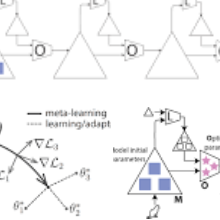Zero-shot learning (ZSL) aims to transfer knowledge from seen classes to semantically related unseen classes, which are absent during training. The promising strategies for ZSL are to synthesize visual features of unseen classes conditioned on semantic side information and to incorporate meta-learning to eliminate the model's inherent bias towards seen classes. While existing meta generative approaches pursue a common model shared across task distributions, we aim to construct a generative network adaptive to task characteristics. To this end, we propose an Attribute-Modulated generAtive meta-model for Zero-shot learning (AMAZ). Our model consists of an attribute-aware modulation network, an attribute-augmented generative network, and an attribute-weighted classifier. Given unseen classes, the modulation network adaptively modulates the generator by applying task-specific transformations so that the generative network can adapt to highly diverse tasks. The weighted classifier utilizes the data quality to enhance the training procedure, further improving the model performance. Our empirical evaluations on four widely-used benchmarks show that AMAZ outperforms state-of-the-art methods by 3.8% and 3.1% in ZSL and generalized ZSL settings, respectively, demonstrating the superiority of our method. Our experiments on a zero-shot image retrieval task show AMAZ's ability to synthesize instances that portray real visual characteristics.
翻译:零光学习( ZSL) 旨在将知识从可见班级转移到培训期间缺失的、与语义相关的隐蔽班级。 ZSL的有希望的战略是综合以语义侧面信息为条件的隐蔽班级的视觉特征,并纳入元学习,以消除模型对外观班的固有偏向。虽然现有的元化方法追求一个在任务分布之间共享的共同模式,但我们的目标是建立一个适应任务特点的基因化网络。为此,我们建议为零光学习(AMAZ)建立一个属性调整基因模型。我们的模型包括一个属性觉悟调节网络,一个属性放大的基因化网络,以及一个属性加权的分类化分类器。鉴于隐蔽的班级,调整网络通过应用特定任务的变化来适应发电机,使基因化网络能够适应高度多样化的任务。为此,加权分类器利用数据质量来提高培训程序,进一步改进模型的性能。我们对四个广泛使用的基准进行了实验性评估,显示AMAZ的视觉能力调整过程超越了我们AMAZ的自我标定型的自我标定的自我标定的自我标定的自我标定的自我定位的A3.A- SAL- SAL- sal- sal- sal- sal- sal- sal- slaus- slaus- sal- sal- sal- sal- sal- sal- sal- sal- sal- slaus




